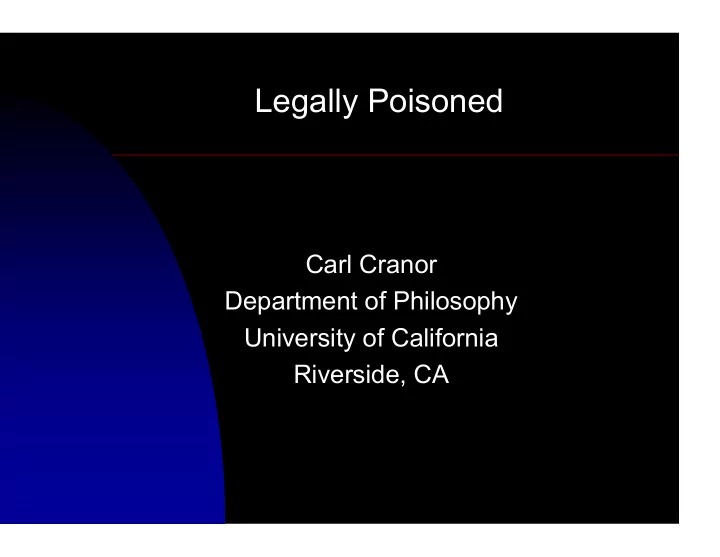

Legally Poisoned Carl Cranor Department of Philosophy University of California Riverside, CA
Science And the Law Molecules can also pose risks or cause harms, but diagnosing their adverse effects is much more subtle and difficult than for the grosser forms of violence. CH 3 Diethylstilbestrol Diethylstilbestrol In utero exposure OH caused cervical cancer HO at age 20, breast cancer later. H 3 C How can we utilize the law and science to reduce the risks to children from toxic molecules?
Highlights of Some Recent Science U.S. citizens are contaminated by up to 212 manmade substances; there will be more (CDC, 2009) . Women’s contamination is shared with developing children in utero --the placenta is no significant barrier. Children have been born with up to 232 industrial chemicals in their bodies.
Women’s Chemical Burden is Shared with Developing Fetuses and Newborns 1965: The womb was seen as a time capsule, relative impermeable to circulating drugs or toxicants. (Needleman Bellinger, 1994) Contradicted by the social catastrophes of methylmercury (1960s), thalidomide (1960s), and DES (1971). Now much more evidence.
Women’s Chemical Burden is Shared with Developing Fetuses and Newborns There is “no placental barrier per se : the vast majority of chemicals given the pregnant animal (or woman) reach the fetus in significant concentrations soon after administration.” (Schardein, 2002) Plastic naonoparticles can move from mom to baby through placenta. 29 March 2010 “Research shows for the first time that plastic nanoparticles can cross the human placenta, possibly exposing the developing fetus to the tiny materials that are increasingly used in medicines, vaccines and personal care products .” (EHN.org)
Development is a genetic Development is an open program system (developmental plasticity, ECO-DEVO) light food hormones toxicants Mother is the fetal Mother is the fetal environment incubator Courtes Ana So
Developing Children Have Greater Exposures They are exposed to larger doses of toxicants relative to the body weight than the mother, via cord blood and breast milk. (Faroe’s Statement, 2007) Lipophilic substances will be concentrated in cord blood and breast milk (PCBs up to 100 times greater). (Heinzow, et. al., 2007) Mercury concentrations can be at least 5 times higher in fetal brain than in mother’s blood. E.g., lead is mobilized as part of the “calcium stream” in pregnant women. (Bellinger & Needleman, 1994)
Developing Children Have Greater Exposures They have Higher metabolism, breathing, absorption rates. (Miller, et. al.) Higher fluid and food intake rates per body weight. (Miller, et. a They play close to ground/floor, “mouth” everything.
Developing Children Have greater exposures. Are more susceptible. Have lesser defenses ( less developed immune system, underdeveloped blood brain barrier, underdeveloped detoxifying enzymes).
Genetic Variation Can Add to The Vulnerability Some developing children are more susceptible to polycyclic aromatic hydrocarbons (byproducts of combustion, e.g., tobacco smoke, urban smoke). (Perrara, et. al. Some are more susceptible to organophosphate pesticides. (Eskenazi, et. al., 2008)
Generalized Additive Affects Can Increase Vulnerability Substances can affect different “upstream” pathways producing jointly additive effects, but not affecting the same cellular receptors: Dioxin-like PCBs affect one pathway, reducing thyroid concentrations in pregnant women, creating neurological hazards to fetuses. Non-dioxin-like PCBs affect another pathway with the same results. (Woodruff, et. al., EHP, 2008) Brominated fire retardants (PBDEs) likely have similar effects because of similarity to non-dioxin-like PCBs.
Some Conclusions Molecular or nano contamination are not the problem; that is inevitable, unavoidable. Contamination by toxicants is the problem. We must determine the toxicity of molecules and nano particles before the public and workforce are exposed; otherwise citizens become experimental subjects. The law permits toxic contamination; it can prevent it.
General recommendations summary Should come with N-product Should come with N-produ Need premarket testing data before this Too postmarket Will likely be postmarket Should come with N-prod Strongly a
Thank you
Recommend
More recommend